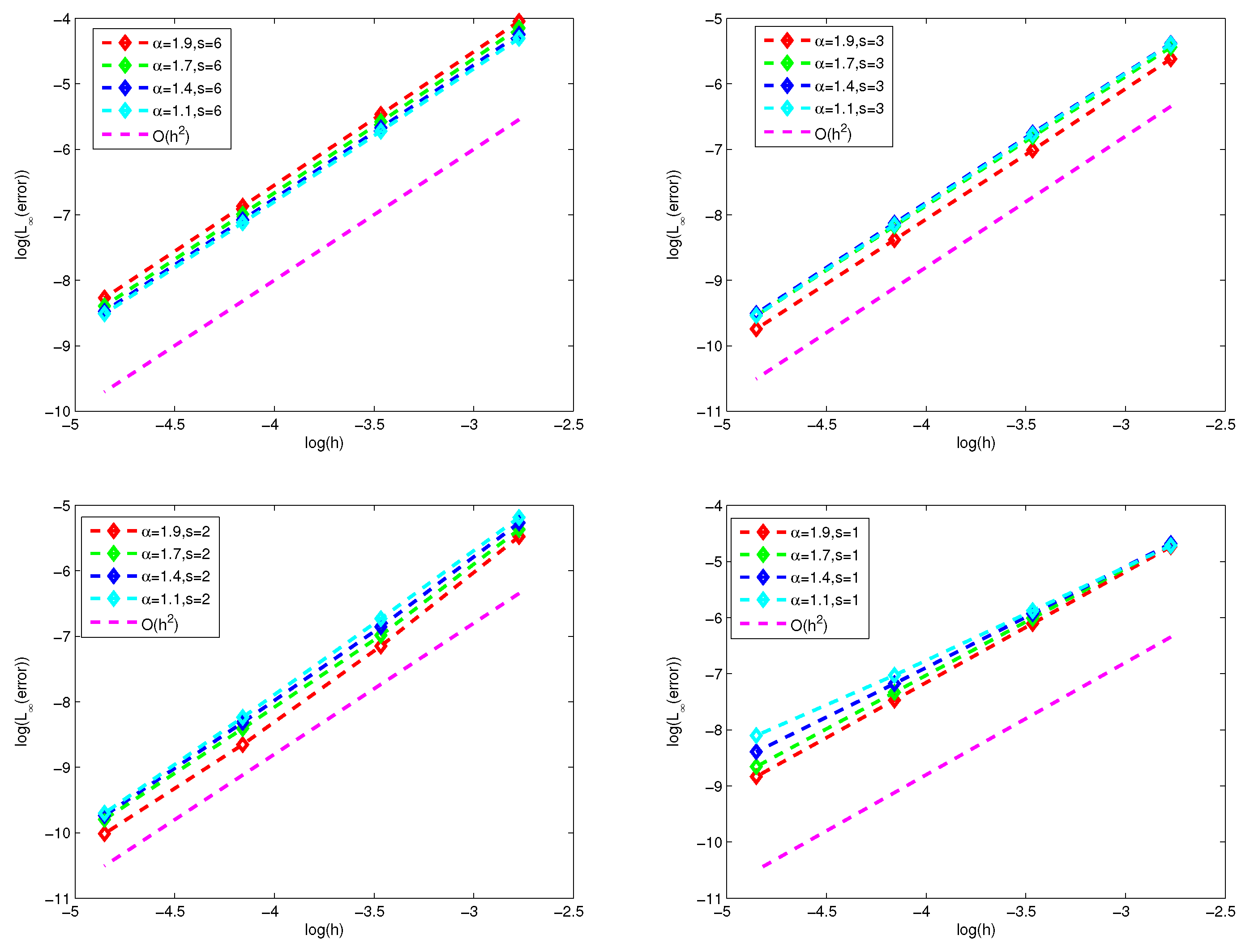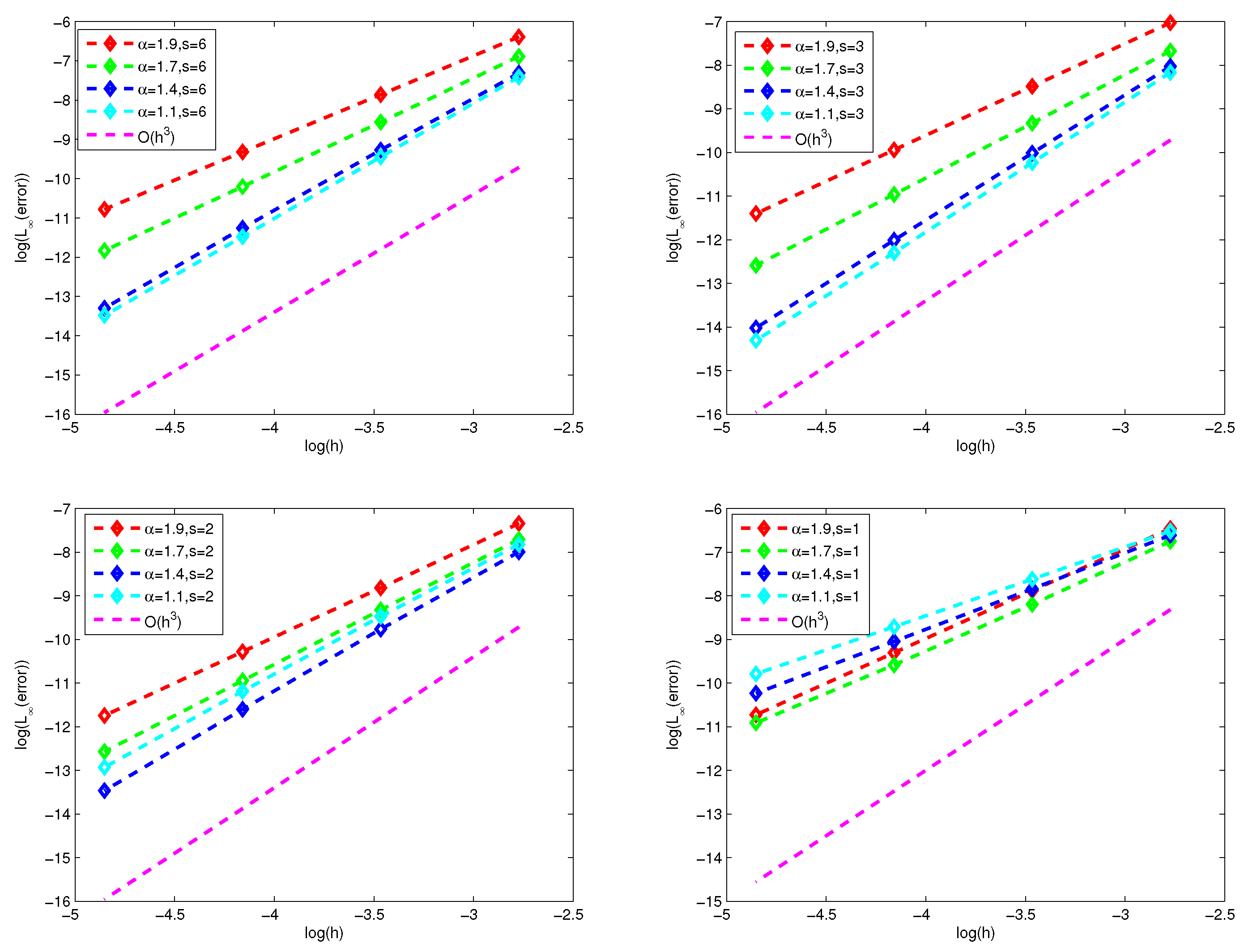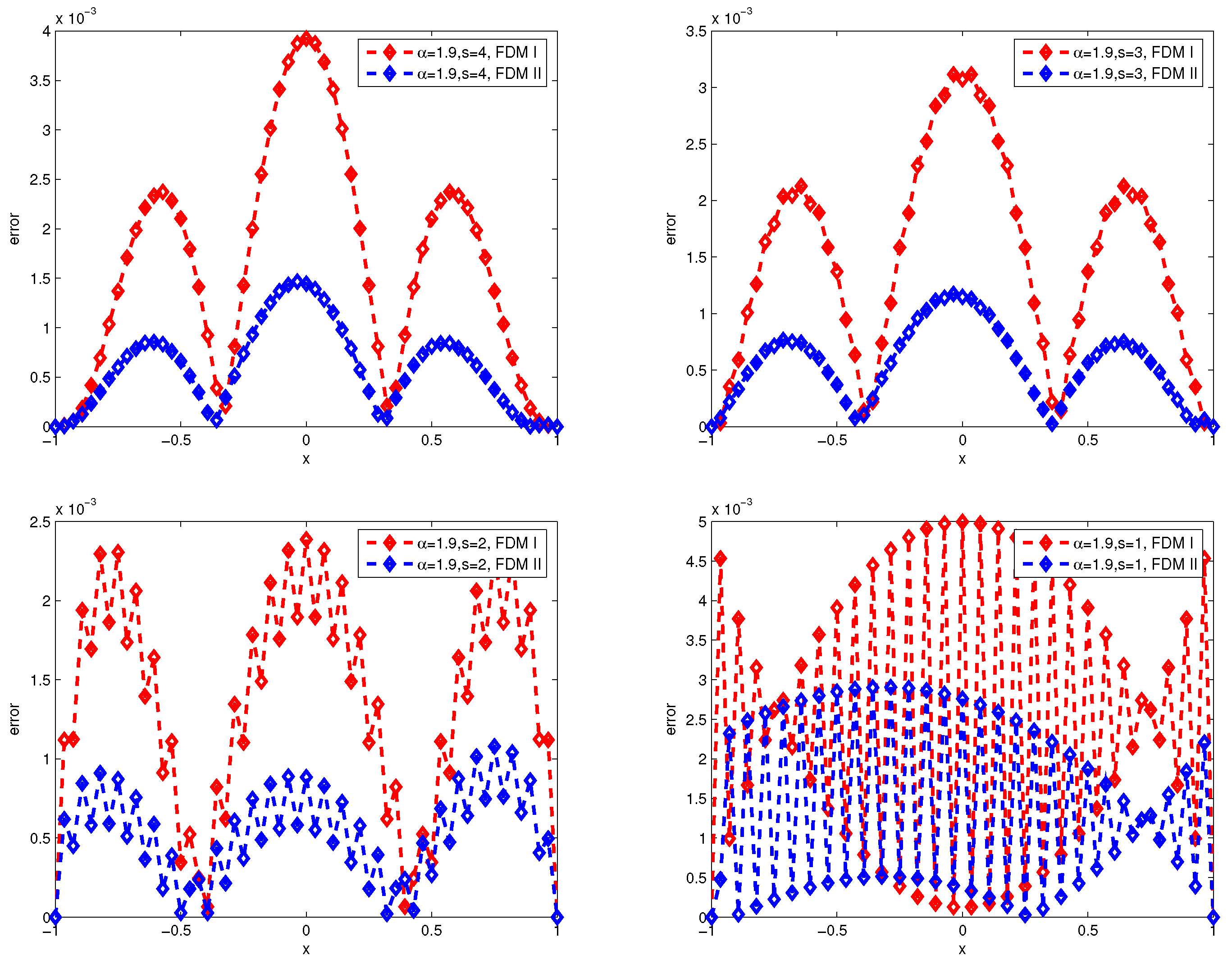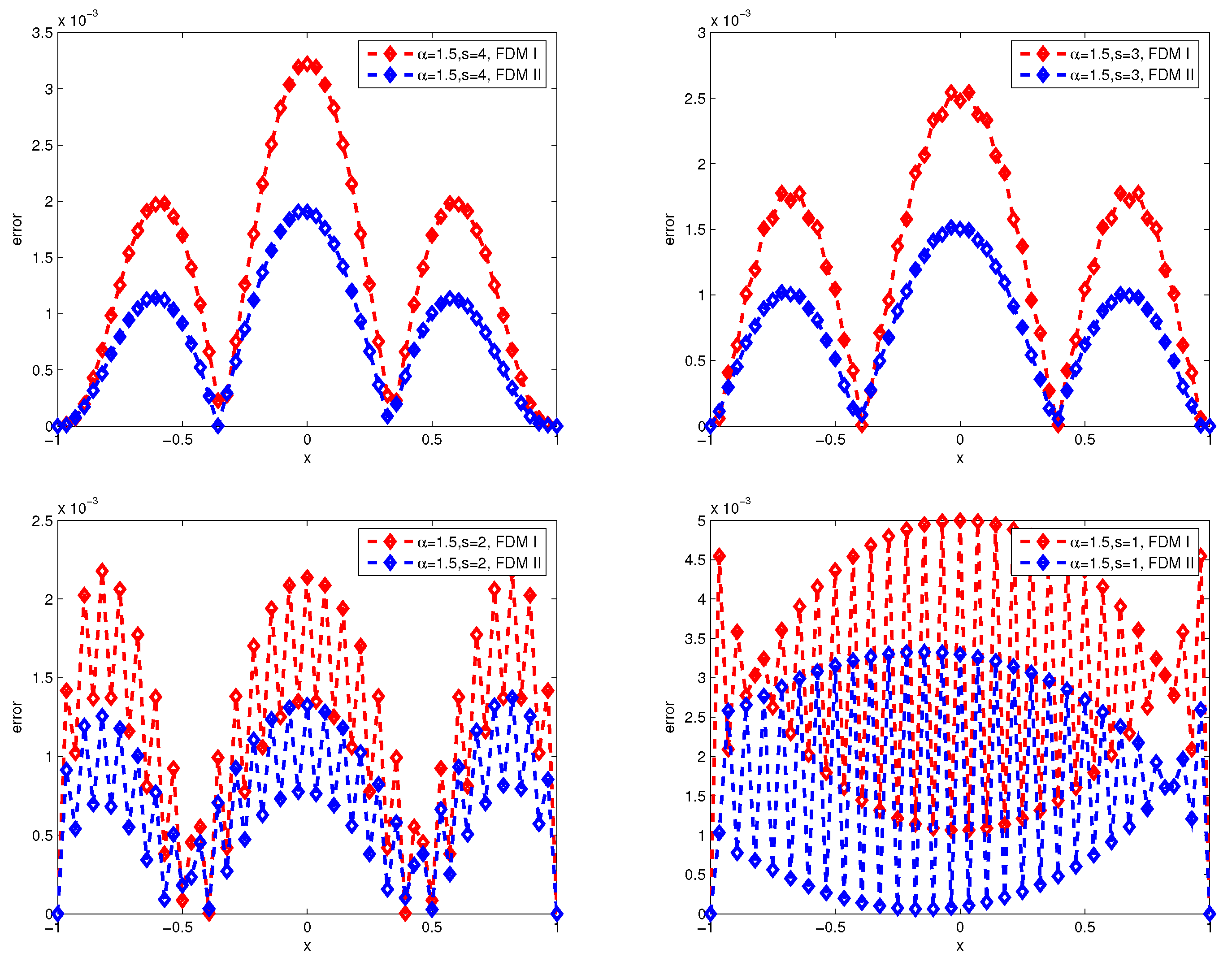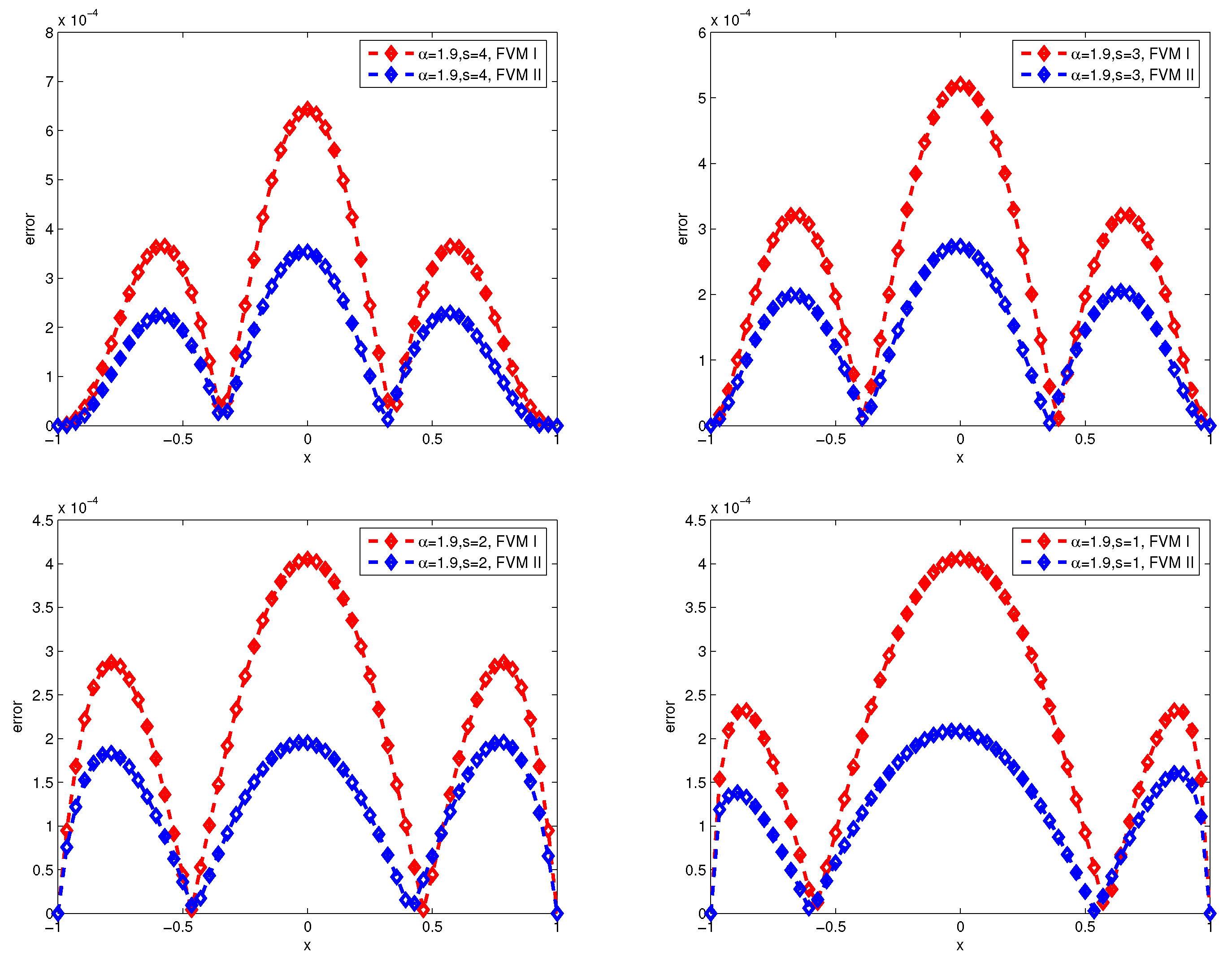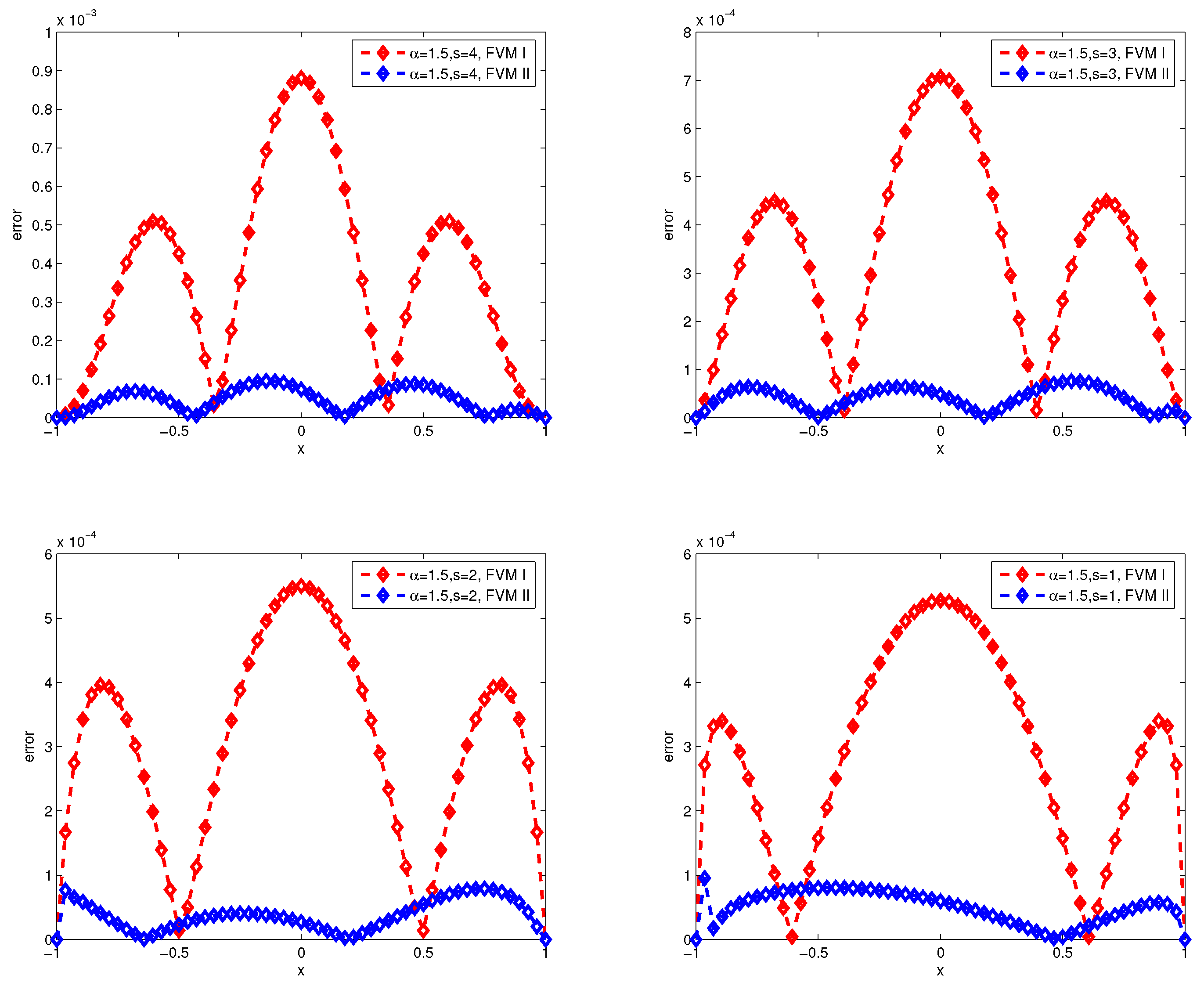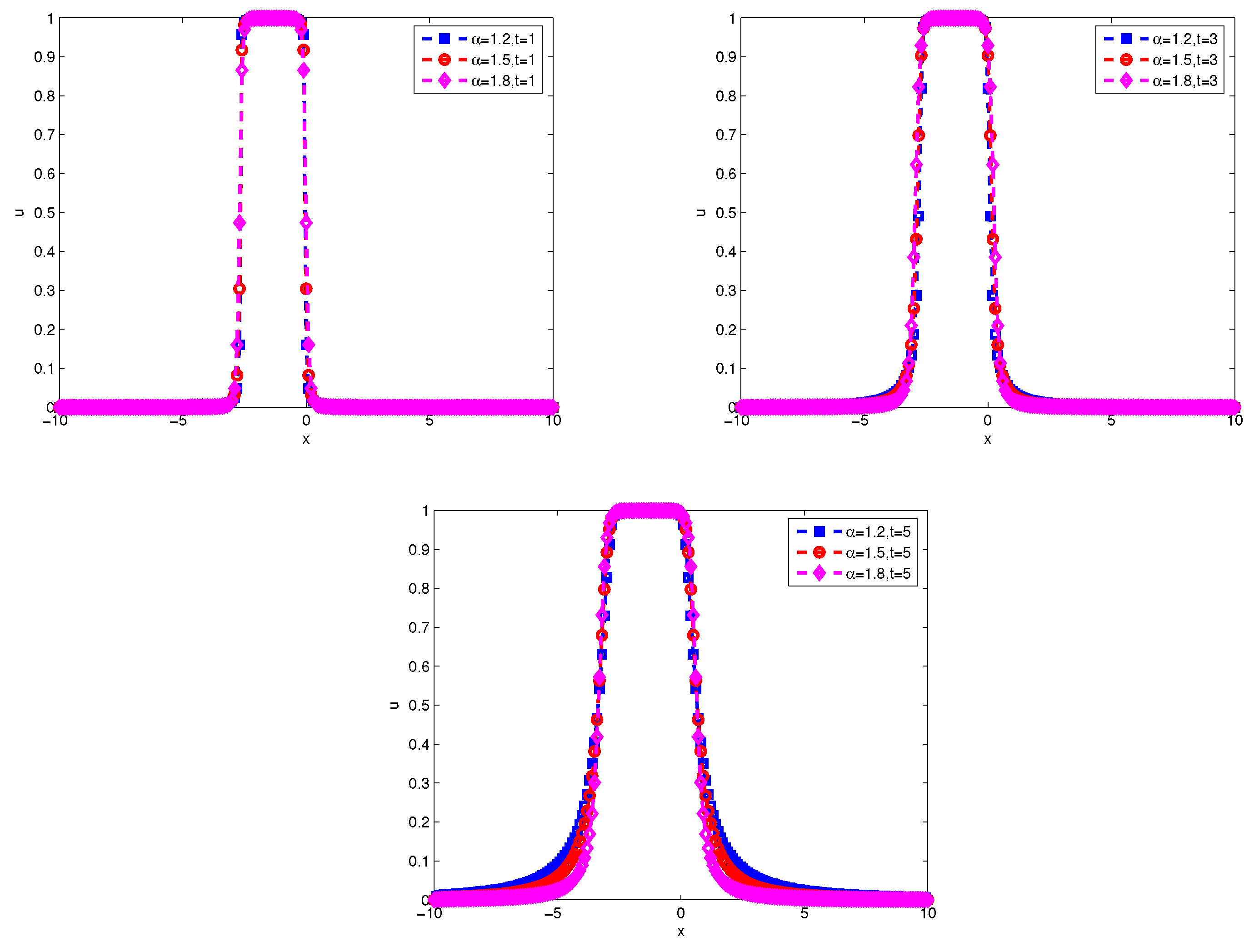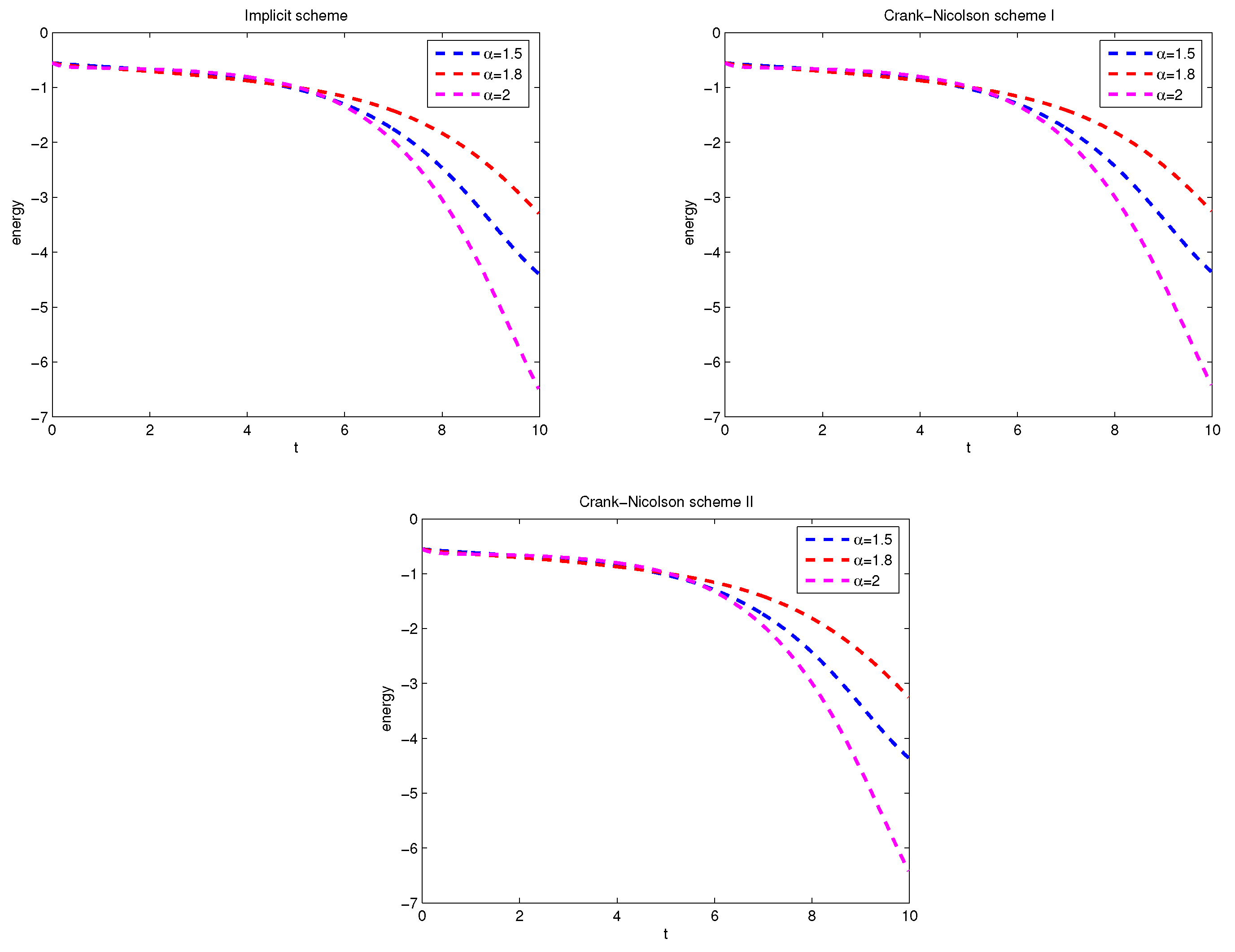1. Introduction
The fractional Laplacian operator is a very important fractional operator that is often used to describe several phenomena, such as the thin obstacle problem, optimization, finance, phase transitions, stratified materials, anomalous diffusion, etc., and it can be defined by the following form [
1,
2,
3]:
where
is the Fourier transform. It can also be represented as the hypersingular integral form
where
. In particular, one-dimensional fractional Laplacian operator can be expressed as the Riesz fractional derivative [
4,
5,
6,
7,
8]
the where
are left and right Riemann–Liouville fractional derivatives of order
, respectively. When
, the fractional Laplacian operator reduces to the classical Laplacian operator. When
, the fractional Laplacian operator is a nonlocal generalization of the classical Laplacian operator. By investigating the literature about fractional Laplacian operators, we find that most of the numerical methods [
9,
10,
11,
12,
13,
14,
15,
16,
17,
18,
19,
20,
21] for fractional Laplace operators are based on Fourier definition (1). However, the Fourier definition (1) is suitable only for the problems defined either on the whole space or periodic boundary conditions. The fractional Laplacian operator on a bounded domain is of great interest, not only from a mathematical point of view but also in practical applications. Recently, some studies have been carried out on the fractional Laplacian operator with zero boundary conditions. First, based on the Riesz fractional derivative, some finite difference methods, such as the fractional centered difference method, weighted and shifted Grünwald difference method, fourth-order compact method, and the matrix transform method, have been developed for the discrete fractional Laplacian operator. Second, based on the fractional Laplacian operator (2), some numerical methods have been also proposed in [
22,
23,
24,
25,
26] to discretize the fractional Laplacian operator, and they show corresponding theoretical analyses.
A fractional diffusion equation is an important class of fractional differential equations, and it has been successfully used to simulate some physical phenomena, such as the thin obstacle problem, stratified materials, anomalous diffusion, etc. It is usually difficult to obtain the analytical solution of the fractional diffusion equation with the fractional Laplacian operator. Therefore, numerical methods have been playing more and more important roles in fractional diffusion equations [
4,
5,
6]. In fact, some attention has been paid to theories and numerical methods for some fractional diffusion equations with the fractional Laplacian operator. The main difficulties in dealing with the fraction diffusion equation are (i) the fractional Laplacian operator is a nonlocal operator; (ii) the solution of the fractional diffusion equation is usually singular near the boundary; (iii) and the fractional Laplacian operator is a hypersingular integral operator. Recently, some attention has been paid to theories and numerical methods to overcome these difficulties. First, in order to deal with the hypersingular integral representation of the fractional Laplacian operator, the main approach is to change the hypersingular integral into a weak singular integral. Second, in order to resolve the singularity of the nonsmooth solution of the fractional diffusion equation, several numerical approaches [
27,
28] have been developed. In [
27], some nonuniform refined grids have been employed to solve fractional diffusion equations with nonsmooth solutions at the end-points. In [
28], an improved algorithm based on a finite difference scheme has been employed to solve the fractional diffusion equation with a nonsmooth solution. In addition, in order to deal with the nonsmooth solution of the fractional diffusion equation, other numerical methods, such as nonuniform refined grids, correction convolution quadrature, and some nonpolynomial basis functions, have also been developed, and they display corresponding theoretical analyses. However, in these works, only classical interpolation functions are considered. As far as we know, there exist few studies on fractional interpolation functions [
29] for the fractional diffusion equation with the fractional Laplacian operator. The main goal of this paper is to construct some numerical schemes for the fractional Laplacian operator based on a fractional interpolation function with zero boundary conditions and apply the resulting numerical schemes to solve some fractional diffusion equations.
In this paper, we mainly use the finite difference method and finite volume method to discretize the fractional Laplacian operator and fractional diffusion equation with zero boundary conditions. First, we deal with the hypersingular integral representation of the fractional Laplacian operator as a weak singular integral by an integral operator . Second, because the solution of the fractional diffusion equation is usually singular near the boundary, we use a fractional interpolation function in the region near the boundary based on some lemmas and use a classical interpolation function in other intervals. Moreover, applying the resulting numerical scheme of the fractional Laplacian operator to the fractional diffusion equation, we show some corresponding theoretical analyses. Third, we also show a finite volume scheme to solve the fractional Laplacian operator and fractional diffusion equation by fractional interpolation function and classical interpolation function. For simplicity’s sake, we only consider numerical schemes for uniform dissection, but it is easy to generalize to nonuniform dissection by a similar approach.
The outline of this paper is as follows. In
Section 2, we present the finite difference scheme to deal with the fractional Laplacian operator by fractional interpolation function and classical interpolation function and apply the resulting numerical scheme to solve some fractional diffusion equations. In
Section 3, we present the finite volume scheme to deal with the fractional Laplacian operator and fractional diffuse equation and show the corresponding theoretical analysis. In
Section 4, the numerical experiments are conducted, and the results verify the efficiency of the schemes. Finally, some conclusions and a discussion are given in
Section 5.
2. Finite Difference Method for Fractional Laplacian Operator and Fractional Diffusion Equation
Some finite difference schemes have been designed for the discrete fractional Laplacian operator based on the Riesz fractional derivative, including the shifted Grünwald formula, second-order weighted, shifted Grünwald–Letnikov difference formula, fractional central difference scheme, etc. However, little attention has been paid to approximating the hypersingular integral definition by fractional interpolation function. In this section, we show a finite difference scheme for the fractional Laplacian operator and fractional diffusion equation with zero boundary condition by fractional interpolation function and classical interpolation function.
2.1. Finite Difference Scheme for Fractional Laplacian Operator
From a physical point of view, the fractional Laplacian operator plays a crucial role in describing several phenomena, such as the thin obstacle problem, optimization, phase transitions, anomalous diffusion, etc. In order to deal with the hypersingular integral representation of the fractional Laplacian operator, one key idea is to deal with the hypersingular integral representation of the fractional Laplacian operator as a weak singular integral.
Under the zero boundary condition
, it follows from [
12] that the fractional Laplacian operator can be expressed as
where
In this paper, we only consider a numerical scheme for uniform dissection on interval
. However, it is easy to obtain the numerical scheme for nonuniform dissection on interval
by a similar approach. For a positive integer
N, we set
,
. Define the linear interpolation function of
as
, i.e.,
It follows from the central difference scheme that the fractional Laplacian operator (3) can be expressed as the following form
Now, we consider a numerical scheme for the weak singular integral (4). Let
,
. Then, the integral operator
can be expressed by
We use
to approximate
on every interval
, and substituting (6) into (8) can yield
where
When
, the integral operator
can be expressed as
Substituting (6) into (10) can yield
where
It follows from numerical schemes (7), (9), and (11) that the fractional Laplacian operator can be approximated by
The solution of a fractional diffusion equation is usually singular near the boundary. In order to resolve the singularity of the nonsmooth solution of the fractional diffusion equation, some numerical methods have been designed for the discrete fractional Laplacian operator based on nonuniform refined grids. However, little attention has been paid to the fractional interpolation function to deal with fractional problems. In this section, we use the fractional interpolation function for the discrete fractional Laplacian operator.
Lemma 1 ([
29]).
Let . Then, we have is linearly independent. Lemma 2 ([
29]).
Given different interpolation points and . LetandThen, the fractional interpolation function can be expressed as the following form:where the fractional interpolation basis function is expressed as Because the solution of a fractional diffusion equation is usually singular near the boundary, we use the fractional interpolation function
to approximate
on
and use the classical interpolation function
to approximate
on every interval
. Moreover,
can be represented by the following form:
where
is the classical interpolation basis function, and
When
, substituting the above interpolation function into the weak singular integral operator (8) can yield
When
, the weak singular integral (10) can be approximated by
In this paper, we only consider the following fractional interpolation function and classical interpolation function to approach
, i.e.,
It is easy to obtain
where
. It is easy to obtain the numerical scheme for other complicated interpolation functions by a similar approach.
Suppose
, we use
to approximate
on the two small intervals
and
to approximate
on the interval
. When
, substituting (14)–(16) into (8) can yield
where
and
When
, weak singular integrals (10) can be approximated by
where
and
It follows from schemes (7), (20), and (21) that the fractional Laplacian operator can be approximated by
2.2. Finite Difference Scheme for Fractional Diffusion Equation
In the last subsection, we showed two numerical schemes of the fractional Laplacian operator based on interpolation functions (6) and (14)–(16). In this subsection, we apply the numerical schemes to solve the following fractional diffusion equation:
First, applying numerical scheme (12)–(13) of the fractional Laplacian operator to fractional diffusion Equation (
24), we can obtain the following discrete numerical schemes:
where
, and
I is the unit matrix. When
, then
when
, then
Second, applying numerical scheme (22)–(23) of the fractional Laplacian operator to fractional diffusion Equation (
24), we can obtain the following discrete numerical schemes:
when
, then
when
, then
Theorem 1. When ,, the matrix is a symmetric matrix and strictly row-wise diagonally dominant.
Proof. When
,
satisfy
. Then, we have
Thus,
is a symmetric matrix.
Now, we prove the matrix
is strictly row-wise diagonally dominant. Let
Then,
. Let
Then,
Let
. Then,
It follows from [
5] that
. Thus,
. It follows from (32) that
With the same method, we can obtain
.
It follows from (30)–(31) that
. According to (30)–(31) and (34), we obtain
and
. It follows from Taylor’s formula that
and
According to (34), we obtain
.
Let
. Then,
□
In a similar method, the matrix is also a symmetric matrix and strictly row-wise diagonally dominant.
5. Conclusions
In the paper, we show the finite difference method and finite volume method for fractional diffuse equations by fractional interpolation function and classical interpolation function with zero boundary conditions. The novelty of our method is that we deal with the hypersingular integral representation of the fractional Laplacian operator as a weak singular integral by an integral operator . Because the solution of the fractional diffusion equation is usually singular near the boundary, we use the fractional interpolation function in the boundary region to approach the fractional Laplacian operator based on some lemmas, and we use the classical interpolation function in the inner region. Then, it is found that the differential matrix of the above scheme is a symmetric matrix and strictly row-wise diagonally dominant in special fractional interpolation functions. Moreover, it is easy to extend the numerical scheme for nonuniform dissection by a similar approach. Finally, several numerical examples are considered to demonstrate the validity and applicability of the numerical scheme to approximate fractional diffusion equations.
In future work, this method will be extended to solve fractional nonlinear Schröinger, Klein–Gordon–Schrödinger equations, etc., with zero boundary conditions. Moreover, we will also try to extend the method to solve the high-dimensional diffuse equation with zero boundary conditions.
